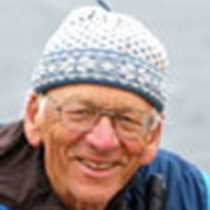Grenville Channel, British Columbia
During the night we passed through Dixon Entrance in calm conditions. This open body of water separates Southeast Alaska from northern British Columbia, Canada. The morning was partially overcast as we started into the northern end of the long narrow passage called Grenville Channel. Many people gathered on the deck after breakfast to watch as we cruised along the steep sided-forested shores on both sides of the ship. A number of Bald Eagles were spotted in the tops of trees. Then a bird of a different kind appeared low over the channel and coming from the north. Since we had just passed into Canadian waters we were first going to have to clear officially into the country. Our local agent from Prince Rupert had arranged for the officials to meet us in a small bay just off the Grenville Channel’s northern section. As we turned to pull into the end of the bay a Zodiac was lowered and the officials were transported to the Sea Bird so we could quickly take care of the formalities.
All of us having shown ourselves to the officials and answered a few questions then prepared to go ashore or kayak. The tide was low so the landing was at the end of the bay where there was a gentle sloping flats partially covered with kelp and other marine organisms of interest. A group of walkers headed across the mudflats and then on higher ground the meadow to explore the forest. Another group prepared to paddle their kayaks quietly over the calm waters of the bay. The walkers discovered a lovely forest towering over a small babbling brook. As they made their way through the forest some new plants were discovered that were not seen on previous hikes. Being further south we were getting into the range of some different more southern species. On one large Silver fir there had been a large piece of bark torn from the side by a hungry Brown Bear. The paddlers discovered numerous intertidal organisms clinging to the rocks along the shore that were exposed at this low tide.
For the rest of the day we cruised southward through the Inland waterways of coastal British Columbia. Because this route is protected by the numerous islands, boats and ships also use the passage. Through out the day we observed different kinds of water vessels moving both north and south. The backdrop was constantly changing as we passed stunning mountain scenes of forest, rock cliffs, and waterfalls. All of the area carved by glaciers some thousands of years ago. In the afternoon we also enjoyed an introductory talk by staff naturalist, David Stephens on the culture and art of the native people that have lived along this coast for centuries and who we would meet tomorrow.
During the night we passed through Dixon Entrance in calm conditions. This open body of water separates Southeast Alaska from northern British Columbia, Canada. The morning was partially overcast as we started into the northern end of the long narrow passage called Grenville Channel. Many people gathered on the deck after breakfast to watch as we cruised along the steep sided-forested shores on both sides of the ship. A number of Bald Eagles were spotted in the tops of trees. Then a bird of a different kind appeared low over the channel and coming from the north. Since we had just passed into Canadian waters we were first going to have to clear officially into the country. Our local agent from Prince Rupert had arranged for the officials to meet us in a small bay just off the Grenville Channel’s northern section. As we turned to pull into the end of the bay a Zodiac was lowered and the officials were transported to the Sea Bird so we could quickly take care of the formalities.
All of us having shown ourselves to the officials and answered a few questions then prepared to go ashore or kayak. The tide was low so the landing was at the end of the bay where there was a gentle sloping flats partially covered with kelp and other marine organisms of interest. A group of walkers headed across the mudflats and then on higher ground the meadow to explore the forest. Another group prepared to paddle their kayaks quietly over the calm waters of the bay. The walkers discovered a lovely forest towering over a small babbling brook. As they made their way through the forest some new plants were discovered that were not seen on previous hikes. Being further south we were getting into the range of some different more southern species. On one large Silver fir there had been a large piece of bark torn from the side by a hungry Brown Bear. The paddlers discovered numerous intertidal organisms clinging to the rocks along the shore that were exposed at this low tide.
For the rest of the day we cruised southward through the Inland waterways of coastal British Columbia. Because this route is protected by the numerous islands, boats and ships also use the passage. Through out the day we observed different kinds of water vessels moving both north and south. The backdrop was constantly changing as we passed stunning mountain scenes of forest, rock cliffs, and waterfalls. All of the area carved by glaciers some thousands of years ago. In the afternoon we also enjoyed an introductory talk by staff naturalist, David Stephens on the culture and art of the native people that have lived along this coast for centuries and who we would meet tomorrow.




